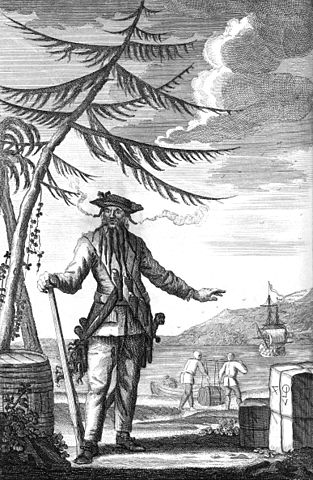
September 9, 2015, by Harry Cocks
The Pirate Myth: Genealogies of an Imperial concept
The English pirate Edward Teach (c 1680-1718, pictured), “assumed the Cognomen of Black-beard, from that large Quantity of Hair, which, like a frightful Meteor, covered his whole Face, and frightened America more than any Comet that has appeared there a long Time” (Charles Johnson, A General History of the Robberies and Murders of the Most Notorious Pyrates, 1724) Teach spent several years attacking shipping off the Atlantic coast of north and south America, before being finally hunted down by the British navy off Virginia in 1718. His head was reported to have flown from his adversaries’ bowsprit. But how did figures like Teach, and many other figures of piracy, come to be defined as enemies of the human race? That is the question posed in a new book The Pirate Myth: Genealogies of an Imperial Concept (Routledge, 2015) by Amedeo Policante, who is joining Nottingham History from our Malaysia campus in an exchange with our medievalist Richard Goddard, and will teach a course on piracy and its meanings.
The charge of piracy has been levelled at various times against a wide variety of groups, Policante notes, including the Barbary corsairs of the seventeenth century, nineteenth-century Malay rovers, contemporary Islamist terrorists, African slavers, anarchist agitators, German submarines, Indian copyright violators defying a global empire of authorial protection, and the Somali raiders of global shipping in our own times. What rhetorical, strategic and political function is served by the figure of the pirate and his (or her) appearance in these arguments?
The pirate, Dr Policante argues, was a necessary accompaniment to schemes of imperial expansion and authority. Hegemonic forces, he argues, have tried to legitimize their claims to some form of global Imperial authority by appealing to the existence of pirates and demanding some kind of measures against them. In those schemes, the fight against international criminals requires a global police force, international criminal justice, and an imperial bureaucracy. All of these were first proposed in order to police the seas and then extended to other “lawless” areas of geography and culture. In that sense, the figure of the pirate “had an essential role in the authoritative discourses of sovereignty” and has throughout modernity “represented the image of an untameable outside against which the state, Empire and finally humanity have been called into action.”
The global economy would not have come into being without collective action by European states against pirates, Policante argues. Karl Marx’s question, ‘would the world market ever have come into being but for national crime?’ applies equally to international piracy. It was, Dr Policante suggests, “one of the fundamental chapters in the history of the formation of the world market.” This operated in two ways: lawless plunder had a fundamental role to play in early Imperialism and in the origins of capitalism, while the suppression of piracy and the increasing extension of international law to the oceans created some of essential preconditions for the creation of global markets. Without these processes, Dr Policante suggests, contemporary globalization would have been unthinkable.
Figures from the Golden Age of piracy (c.1670-1720), like Blackbeard, hold their romantic appeal because, Policante argues, they “represent the last sentinels of a fading conception of the oceans as a space of absolute freedom.”
The Pirate Myth: Genealogies of an Imperial Concept (Routledge, 2015)
http://www.taylorandfrancis.com/articles/featured_author_amedeo_policante/
No comments yet, fill out a comment to be the first

Leave a Reply